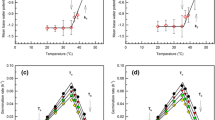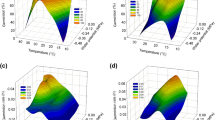Abstract
Ambient temperatures are major factors regulating the growth rates, yields, and geographical distribution of crop species. The cultivation of sesame (Sesamum indicum L.) is expanding with the rising demand in regions where it is not traditionally grown, and sub-optimal yields due to extremely low or high temperatures could occur. Currently literature lacks information on the temperature responses of sesame growth. An experiment was conducted to quantify the effects of different temperatures on vegetative growth and reproductive development of sesame, and to estimate its cardinal temperature limits (Topt; Tmin; Tmax). Plants were subjected to six different day/night temperature treatments of 40/32, 36/28, 32/24, 28/20, and 20/12 °C using walk-in growth chambers. Vegetative growth of sesame was sensitive to low temperatures (< 15 °C), but tolerant of high temperatures. The cardinal temperature limits of 15.7 °C (Tmin), 27.3 °C (Topt), and 44.6 °C (Tmax) were observed for rate of biomass accumulation. Sesame reached the flowering stage under moderate to high temperature conditions; however, reproductive yields progressively declined above 25 °C, and no seed yields were obtained beyond 33 °C. The estimated temperature limits could be employed to develop crop models for simulating management and adaptation strategies of sesame under current and future climate scenarios, and adaptation to regions where the crop is not currently grown. Future research should focus on understanding factors controlling the temperature tolerance of reproductive development in sesame, to provide a broader geographical adaptation.





Similar content being viewed by others
References
Acar I, Kakani VG (2010) The effects of temperature on in vitro pollen germination and pollen tube growth of Pistacia spp. Sci Hortic 125(4):569–572
Amoo S, Okorogbona A, Du Plooy C, Venter S (2017) Sesamum indicum. Medicinal spices and vegetables from Africa. Elsevier, Amsterdam, pp 549–579
Baath GS, Kakani VG, Gowda PH, Rocateli AC, Northup BK, Singh H, Katta JR (2020) Guar responses to temperature: estimation of cardinal temperatures and photosynthetic parameters. Ind Crops Prod 145:111940
Bahuguna RN, Jagadish KS (2015) Temperature regulation of plant phenological development. Environ Exp Bot 111:83–90
Bakhshandeh E, Atashi S, Hafez-Nia M, Pirdashti H (2013) Quantification of the response of germination rate to temperature in sesame (Sesamum indicum). Seed Sci TECHNOL 41(3):469–473
Bakhshandeh E, Jamali M, Afshoon E, Gholamhossieni M (2017) Using hydrothermal time concept to describe sesame (Sesamum indicum L.) seed germination response to temperature and water potential. Acta Physiolog Plant 39(11):250
Bedigian D (2010) Characterization of sesame (Sesamum indicum L.) germplasm: a critique. Genet Resour Crop Evol 57(5):641–647
Berry J, Bjorkman O (1980) Photosynthetic response and adaptation to temperature in higher plants. Annu Rev Plant Physiol 31(1):491–543
Boote KJ, Jones JW, Hoogenboom G, Pickering N (1998) Simulation of crop growth: CROPGRO model. Agric Syst Model Simul 18:651–692
Couch A, Gloaguen RM, Langham DR, Hochmuth GJ, Bennett JM, Rowland DL (2017) Non-dehiscent sesame (Sesamum indicum L.): its unique production potential and expansion into the southeastern USA. J Crop Improv 31(2):101–172
dos Santos MG, Ribeiro RMP, de Albuquerque JRT, Lins HA, Júnior APB, Neto FB, da Silveira LM, Soares EB, de Souza ARE (2018) Production performance of sesame cultivars under different nitrogen rates in two crops in the Brazilian semi-arid region. Ind Crops Prod 124:1–8
Elleuch M, Bedigian D, Zitoun A (2011) Sesame (Sesamum indicum L.) seeds in food, nutrition, and health. Nuts and seeds in health and disease prevention. Elsevier, Amsterdam, pp 1029–1036
FAOSTAT (2019) Food and Agriculture Organization statistics database. FAO, Rome. http://www.fao.org/faostat/en/#data/QC. Accessed 5 Dec 2019
Guilioni L, Wery J, Tardieu F (1997) Heat stress-induced abortion of buds and flowers in pea: is sensitivity linked to organ age or to relations between reproductive organs? Ann Bot 80:159–168
Hailu E, Urga Y, Sori N, Borona F, Tufa K (2018) Sesame yield response to deficit irrigation and water application techniques in irrigated agriculture, Ethiopia. Int J Agron. https://doi.org/10.1155/2018/5084056
Hatfield JL, Prueger JH (2015) Temperature extremes: Effect on plant growth and development. Weather Clim Extremes 10:4–10
Hatfield JL, Boote KJ, Kimball B, Ziska L, Izaurralde RC, Ort D, Thomson AM, Wolfe D (2011) Climate impacts on agriculture: implications for crop production. Agron J 103(2):351–370
Hedhly A (2011) Sensitivity of flowering plant gametophytes to temperature fluctuations. Environ Exp Bot 74:9–16
Kakani V, Prasad P, Craufurd P, Wheeler T (2002) Response of in vitro pollen germination and pollen tube growth of groundnut (Arachis hypogaea L.) genotypes to temperature. Plant Cell Environ 25(12):1651–1661
Kakani V, Reddy K, Koti S, Wallace T, Prasad P, Reddy V, Zhao D (2005) Differences in in vitro pollen germination and pollen tube growth of cotton cultivars in response to high temperature. Ann Bot 96(1):59–67
Kassie BT, Asseng S, Rotter RP, Hengsdijk H, Ruane AC, Van Ittersum MK (2015) Exploring climate change impacts and adaptation options for maize production in the Central Rift Valley of Ethiopia using different climate change scenarios and crop models. Clim Change 129(1–2):145–158
Khademian R, Asghari B, Sedaghati B, Yaghoubian Y (2019) Plant beneficial rhizospheric microorganisms (PBRMs) mitigate deleterious effects of salinity in sesame (Sesamum indicum L.): physio-biochemical properties, fatty acids composition and secondary metabolites content. Ind Crops Prod 136:129–139
Kumazaki T, Yamada Y, Karaya S, Tokumitsu T, Hirano T, Yasumoto S, Katsuta M, Michiyama H (2008) Effects of day length and air temperature on stem growth and flowering in sesame. Plant Prod Sci 11:178–183
Lee JH, Ryu H-S, Chung KS, Posé D, Kim S, Schmid M, Ahn JH (2013) Regulation of temperature-responsive flowering by MADS-box transcription factor repressors. Science 342(6158):628–632
Lohani N, Singh MB, Bhalla PL (2020) High temperature susceptibility of sexual reproduction in crop plants. J Exp Bot 71(2):555–568
Lukatkin AS, Brazaityte A, Bobinas C, Duchovskis P (2012) Chilling injury in chilling-sensitive plants: a review. Agriculture 99(2):111–124
Morison J, Lawlor D (1999) Interactions between increasing CO2 concentration and temperature on plant growth. Plant Cell Environ 22(6):659–682
Myers SS, Smith MR, Guth S, Golden CD, Vaitla B, Mueller ND, Dangour AD, Huybers P (2017) Climate change and global food systems: potential impacts on food security and undernutrition. Annu Rev Public Health 38:259–277
Nyongesa BO, Were BA, Gudu S, Dangasuk OG, Onkware AO (2013) Genetic diversity in cultivated sesame (Sesamum indicum L.) and related wild species in East Africa. J Crop Sci Biotechnol 16(1):9–15
Prasad PV, Craufurd P, Summerfield R (2000) Effect of high air and soil temperature on dry matter production, pod yield and yield components of groundnut. Plant Soil 222(1–2):231–239
Reddy KR, Kakani V (2007) Screening Capsicum species of different origins for high temperature tolerance by in vitro pollen germination and pollen tube length. Sci Hortic 112(2):130–135
Reddy K, Hodges H, McKinion J (1993) A temperature model for cotton phenology. Biotronics 22(1):47–59
Reddy KR, Hodges HF, McKinion JM (1995) Carbon dioxide and temperature effects on pima cotton development. Agron J 87(5):820–826
Reddy KR, Vara Prasad P, Kakani VG (2005) Crop responses to elevated carbon dioxide and interactions with temperature: cotton. J Crop Improv 13(1–2):157–191
Rodrigues AF, de Souza TAF, Marques LF, Souto JS, da Silva WP (2016) Agricultural management practices: effects on soil properties, root growth and sesame yield. Russ Agric Sci 42(5):321–327
Ruelland E, Vaultier M-N, Zachowski A, Hurry V (2009) Cold signalling and cold acclimation in plants. Adv Bot Res 49:35–150
Sato S, Peet MM, Gardner RG (2001) Formation of parthenocarpic fruit, undeveloped flowers and aborted flowers in tomato under moderately elevated temperatures. Sci Hortic 90(3–4):243–254
Sato S, Peet MM, Gardner RG (2004) Altered flower retention and developmental patterns in nine tomato cultivars under elevated temperature. Sci Hortic 101(1–2):95–101
SAS Institute (2017) Base SAS 9.4 procedures guide: statistical procedures. SAS Inst, Cary
Singh B, Chastain DR, Jumaa S, Wijewardana C, Redoña ED, Gao W, Reddy KR (2019) Projected day/night temperatures specifically limits rubisco activity and electron transport in diverse rice cultivars. Environ Exp Bot 159:191–199
Suddihiyam P, Steer BT, Turner DW (1992) The flowering of sesame (Sesamum indicum L.) in response to temperature and photoperiod. Aust J Agric Res 43(5):1101–1116
Tyystjärvi E (2013) Photoinhibition of photosystem II. International review of cell and molecular biology, vol 300. Elsevier, Amsterdam, pp 243–303
USDA-NASS (2019) Census of agriculture. US Department of Agriculture, National Agricultural Statiatics Service
Wacal C, Ogata N, Basalirwa D, Handa T, Sasagawa D, Acidri R, Ishigaki T, Kato M, Masunaga T, Yamamoto S (2019) Growth, seed yield, mineral nutrients and soil properties of sesame (Sesamum indicum L.) as influenced by biochar addition on upland field converted from paddy. Agronomy 9(2):55
Yan WK, Wallace DH (1998) Simulation and prediction of plant phenology for five crops based on photoperiod by temperature interaction. Ann Bot 81:705–716
Yin X, Kropff MJ, McLaren G, Visperas RM (1995) A nonlinear model for crop development as a function of temperature. Agric For Meteorol 77(1–2):1–16
Acknowledgements
We gratefully acknowledge the funding support of USDA-ARS Grazinglands Research Laboratory for this research. Authors would like to thank Jay Prater for his technical support and student workers, Jhansy Reddy, Ishan Maplotra, Amritpal Kaur and Harpinder Baath, for their assistance in data collection during the growth chamber studies.
Author information
Authors and Affiliations
Contributions
All authors equally contributed to this work.
Corresponding author
Ethics declarations
Conflict of interest
The authors declare no conflict of interest.
Additional information
Handling Editor: Heather Nonhebel.
Publisher's Note
Springer Nature remains neutral with regard to jurisdictional claims in published maps and institutional affiliations.
Disclaimer Mention of trademarks, proprietary products, or vendors does not constitute guarantee or warranty of products by USDA and does not imply its approval to the exclusion of other products that may be suitable. All programs and services of the USDA are offered on a nondiscriminatory basis, without regard to race, color, national origin, religion, sex, age, marital status, or handicap.
Electronic supplementary material
Below is the link to the electronic supplementary material.
Rights and permissions
About this article
Cite this article
Baath, G.S., Kakani, V.G., Northup, B.K. et al. Quantifying and Modeling the Influence of Temperature on Growth and Reproductive Development of Sesame. J Plant Growth Regul 41, 143–152 (2022). https://doi.org/10.1007/s00344-020-10278-y
Received:
Accepted:
Published:
Issue Date:
DOI: https://doi.org/10.1007/s00344-020-10278-y




